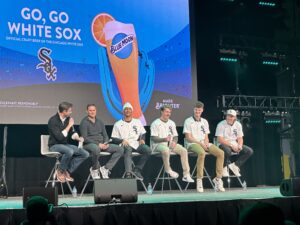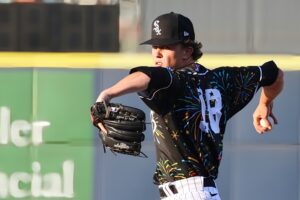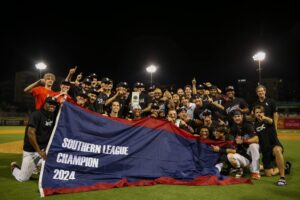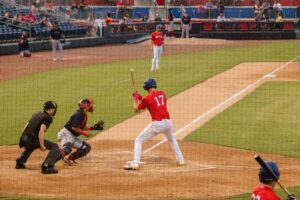Top 30 White Sox Prospects, Midseason 2015 – Full List
Twice annually, the writers at Future Sox work together to produce a list of the top prospects in the White Sox system. We use a voting system among the staff, then argue out specific players and rankings, until we come to a final list. The list is then released in two parts.
This is the complete Top 30 list, with detailed capsules for the top 15. It also includes a list of players who received consideration for the Top 30 but fell just short. For capsules on the players ranked 16-30, see the teaser article published on Monday.
How do we evaluate and rank players? Read this primer to see how we go about it, but suffice to say we look at players from a number of different angles. It is worth noting that our writers have seen 23 of these top 30 prospects in person this season or last, and we’ve interviewed 18 of them.
NOTE ON ELIGIBILITY: We consider a “prospect” any player in the White Sox organization who has not yet achieved MLB Rookie status. This means players like Erik Johnson, despite being the minors, do not qualify.
STATE OF THE SYSTEM: Four of the top thirty from the offseason are no longer eligible: Carlos Rodon (1st) and Carlos Sanchez (8th) have graduated, Andy Wilkins (25th) was traded away, and Mike Recchia (28th) retired from baseball. The current system still lacks the number of high level (sometimes called A-grade) prospects that stronger farms do, but the depth of prospects with some talent and intrigue is actually stronger than we’ve seen in some time. This made for a lot of parity in our voting and some spirited discussions among our writers about who should be there, which is reflected in the longest list of “just missed” players we’ve ever had. This is also the first list in at least a couple years where the top prospect was not unanimous in support – and the player we did end up putting at the top isn’t the same as most other lists out there.
Since our previous list in January we’ve seen spring training, three to four months of season play, international signings and the amateur draft. The list reflects a lot of changes, as 13 of the names on this list were not in our previous Top 30, with the back end of the list being almost entirely new or changed names. That’s a lot of turnover, and a lot of new (or returning) names to know, so let’s get started.
THE LIST
1. Carson Fulmer, RHP [NEW]
- Drafted 1st Round in 2015
Taken as the 8th overall pick in this year’s draft and signed for slot value ($3,470,600), Carson Fulmer immediately becomes the top pitching prospect in the White Sox system. Pre-draft grades generally had Fulmer right around the eighth pick after an impressive career with power college program Vanderbilt (1.99 ERA, 298 K in 257.2 IP over three seasons). You should read this in-depth article looking at Fulmer in detail, but one prevailing theme is his unorthodox, explosive-starting and somewhat violent delivery. That combined with a relatively small frame (a friendly 6’1″ and 190 pounds) does give scouts some pause. But the stuff is impressive – a plus mid-90s fastball that touches 97, power curve that shows plus, and a change-up that is above average with potential for better. Praise for Fulmer’s work ethic was abundant before and after the draft, and he’s definitely got some fire and expression on the mound. The 21-year old opened his pro career with a single tune-up inning for the AZL rookie team, and we had a writer there to take notes and video. He’s since been assigned to Advanced A Winston-Salem and the tutelage of trusted pitching coach J.R. Perdew, similar to the path given Carlos Rodon in 2014. His innings appear to be on a strict limit, and it’s unlikely Fulmer reaches the majors in 2015 (though a promotion to a higher level of the minors isn’t out of the question).
2. Tim Anderson, SS [Previous: 2nd, no change]
- Drafted 1st round (17th overall) in 2013
Tim Anderson came out of nowhere in his draft year, having focused more on basketball than baseball until his junior college career began. Despite his raw baseball skills, he skipped rookie ball to go to Class A Kannapolis where he held his own offensively (.277/.348/.363) and showed off his 80-grade speed on the base paths (24/28 SB/ATT) but struggled on the defensive end and struck out at a pretty high rate (25.9% K/PA). In 2014, Anderson missed some time to a wrist injury, but still posted good results for A+ Winston-Salem (.297/.323/.472, 10 SB in 68 games) and made a late appearance in AA. After showing well in the prospect-rich Arizona Fall League in the offseason, this elite athlete opened 2015 with an aggressive assignment back to Birmingham for his age 21/22 season. There he’s seen further improvement in his hitting results (.307 AVG), improved his contact rate (20.6% K/PA), and keeps stealing bases (40 in 51 attempts). Perhaps more importantly, reports indicate his defense at shortstop has improved noticeably, and he’s now more likely to stick at the position. The raw power potential from his great bat speed isn’t showing through in games much yet, and the walk rate while improving is still low enough to be a caution flag (4.4% BB/PA). But the athleticism and talent here are very high, and with his ability to hit and run, if he can handle shortstop and gain a little more patience at the plate, he could be a special player. Adding some game power would be icing on the cake.
3. Frankie Montas, RHP [Previous: 3rd, no change]
- Acquired in the Jake Peavy trade in 2013
When he was acquired in the Peavy trade, Frankie Montas was another power arm looking for command. Since then he’s broken out in a big way, succeeding as a starter and showing potential for a lot more than just a reliever with a fast heater. In 2014, Montas was a full-time starter for Winston-Salem and blew away Carolina League hitters: 1.60 ERA. 0.95 WHIP, 8.1 K/9 – and suddenly showed excellent control (2.0 BB/9) in his ten starts there. The thick right-hander missed time due to meniscus surgeries in both knees but seemed none the worse for wear, making a single late-season start in AA as a 21-year old. Here in 2015, Frankie/Frank/Francelis/Francellis has been very effective in the Birmingham rotation. The fastball runs anywhere from 95 to 102, though it has better movement in the lower end of that range. He’s also got a slider and a change, both of which have flashed plus characteristics, but neither are consistent offerings yet. Very much related, his delivery also tends to waver. Montas is the perfect example of why control isn’t the same as command – he throws strikes (control), but still struggles to truly locate and tailor velocity of his pitches (command). How well he can consistently command those three pitches will dictate his future role (starter or reliever) and level of success.
4. Spencer Adams, RHP [Previous: 4th, no change]
- Drafted 2nd round in 2014
Spencer Adams was seen as a minor steal in the 2014 draft, falling to the Sox in the 2nd round despite late 1st round pre-draft grades. The lanky right-hander went to rookie ball having just turned 18 in April, and looked the part. Not only were his peripherals ridiculous (59 K, 4 BB in 41.2 IP), but scouts who saw him were dazzled by both the fastball and his slider. 2015 took him to Class A a few days before his 19th birthday, and at first it was a struggle – a 5.55 ERA in his first six starts with half the strikeout rate he had in rookie ball, though he was still throwing strikes. His fastball velocity was down dramatically, from the 93-96 previously seen to more 90-92, and his breaking pitches didn’t have the same bite. While some were concerned about his health or endurance, pitching coach Jose Bautista said he needed to make some mechanical changes which he at first resisted. Now as he’s finally made those adjustments, the velocity has reportedly bounced back some of the way, and the results show the difference – a 2.40 ERA, slightly better K rate, many more ground balls and still very few walks across 10 starts in Kannapolis and 1 spot start in Winston-Salem. Adams is still filling out his frame and is a work in progress, but the potential is high and he’s quite young to be succeeding in full season ball.
5. Micah Johnson, 2B [Previous: 6th, +1]
- Drafted 9th round in 2012
Drafted in the 9th round and putting up good but not great numbers in rookie ball in 2012, Micah Johnson was at best on the periphery of the prospect radar. Then in 2013, he exploded onto the scene going through A, A+ and finishing in AA while posting a .312/.373/.451 line and stealing a whopping 84 bases. In 2014, he returned to Birmingham and hit with authority (.880 OPS), walked nearly as often as struck out, and was promoted to AAA Charlotte where the hitting results dwindled along with his base stealing (due in part to nagging hamstring injuries). To open 2015, Micah showed up in Spring Training and stole the starting second base job in Chicago with a huge Cactus League performance. Unfortunately, while his hitting wasn’t bad, his defense was a liability and he was back in Charlotte by mid-May. There he’s hitting very well (.328/.383/.487) and back to stealing effectively (26 SB in 32 ATT), but just went to the DL with a minor hamstring issue. The questions at this point are almost entirely about his defense – which may or may not have improved somewhat, depending on whose reports you are reading. Recurring health issues do present a wildcard risk as well. With plus speed, a good feel for the bat, decent batter’s eye and a little pop, if he can just be adequate defensively at second base, he’s major league starting material or better. As a position move doesn’t make sense, we’ll have to see how he’s progressed at second, and he likely gets another look in Chicago sometime this year.
6. Trey Michalczewski, 3B [Previous: 9th, +3]
- Drafted 7th round in 2013
Trey Michalczewski (pronounced mee-how-CHESS-key), an over-slot signing in the 7th round of the 2013 draft, has made himself into one of the prized prospects of the White Sox system. The switch-hitter was a shortstop at the powerhouse Jenks High School in Oklahoma, but carries a very typical build for a third baseman at 6’ 3”, 215 lbs, and scouts felt the hot corner was his professional home. The reports on Michalczewski’s defense have been getting better with time and his ability to play the position is crucial for his prospect status. At the plate, Michalczewski has taken a big stride this year and lowered his strikeout percentage to a respectable ~20%. While the home run numbers haven’t been pouring in, Michalczewski has shown plenty of gap power as he has accumulated extra base hits quite frequently. Michalczewski’s ceiling is that of a starting third baseman in the Major Leagues, but he has plenty of time to grow as a 20-year-old in High-A.
7. Tyler Danish, RHP [Previous: 5th, -2]
- Drafted 2nd round in 2013
Known for his wicked arm action and unusual delivery, Tyler Danish finds himself at home in the White Sox system. As a second rounder in the 2013 draft, Danish had basically excelled if not dominated at every stop in his life until this 2015 season in Birmingham. While he is very young for AA in his age 20 season, he is getting beat across the board that has him now wearing a 1.7+ WHIP. Slinging from a three-quarter slot, Danish has a fastball that can touch 93 MPH but has benefited from more movement when throwing with less velocity. His arm slot gives him good movement on his slider but also makes him susceptible to left-handed hitters. While most have him penned as a reliever, the development of his change-up could allow this bulldog to find his way into the back end of a Major League rotation.
8. Micker Adolfo, OF [Previous: 10th, +2]
- Signed as international amateur free agent in 2013 from Dominican Republic
Micker Adolfo’s presence near the top of this list is as a result of one thing: projection. Adolfo carries a scout’s favorite tool in big power, both in the bat and in his right arm. Born in the Virgin Islands, Adolfo is far from your typical July 2nd International Signing as he speaks fluent English already but he still shares that same rawness of his counterparts. Both physically and in polish, the young outfielder has plenty of room to grow. He will need to learn to command of the strike zone and grow into his athletic but currently lanky frame. Adolfo profiles as a right fielder and should have more than enough arm to play the part. He’s a ways away, but is certainly a prospect to watch as perhaps the biggest White Sox amateur international signing of all time. If Adolfo were to put the polish to his potential, he could be 20+ HR guy starting in right field down the road.
9. Courtney Hawkins, OF [Previous: 7th, -2]
- Drafted 1st round (13th overall) in 2012
A former top prospect in the White Sox system, the 13th overall pick in the 2012 draft has had an up-and-down career with the White Sox. Courtney Hawkins, who finds himself in AA Birmingham after two campaigns in Winston-Salem, has struggled to stay on the field this season. It’s clear that health struggles certainly haven’t helped Hawkins’ 2015 campaign and the outfielder has had his contact rate fall again (30.3 K% at current). The defensive reports have been improving as he has an arm good enough for either corner and is said to get good reads off the bat. Regardless, Hawkins’ future is contingent on his plate discipline and whether he can learn to lay off the breaking pitches out of the zone. The raw power is big and it has translated to game power pretty effectively, but that too will be limited to the level of success of his bat to ball skills. Courtney is quite young for level at 21, so it probably makes sense for him to repeat AA next year (much like the next prospect on this list did) and allow his pitch recognition and plate approach to catch up.
10. Trayce Thompson, OF [Previous: 17th, +7]
- Drafted 2nd round in 2009
Thompson was drafted in the second round in 2009 and has made the FutureSox top prospect list for a record six straight years. Interestingly, Trayce Thompson was just called up to play for the White Sox as his brother Klay, the star guard for the Golden State Warriors, leaked his promotion this past weekend. Thompson brings to a baseball club the ability to play good defense at all three outfield positions with plenty of arm. While Thompson doesn’t get on base at a very high clip, he has shown power and a big presence against left-handed pitching. His promotion (and jump up our list) stems from a 2015 season that saw him make his first significant trip to AAA and while improving his contact rate and maintaining that power (though at the expense of walks). Thompson looks like a 4th outfielder right now, but could play himself into a platoon role given his strong defense and ability to hit left-handed pitchers. A starting role isn’t completely out of sight either, if his development continues.
11. Jacob May, OF [Previous: 14th, +3]
- Drafted 3rd round in 2013
Up-the-middle players with elite speed do not grow on trees, and Jacob May has done nothing but encourage in AA Birmingham when he’s played. A scary collision (which resulted in a concussion) sidelined him during the middle of the season, but May has returned, continues to make contact and is active on the base paths. While the strikeout rate (16.9%) is slightly up from last season at A+, the power (.055 ISO) and walk rate down (6.1%), AA is the litmus test for prospects and May has registered a .303/.348/.357 slash line (261 PAs) to date. It is not often that players can make significant adjustments to their game at the AA level, so it is impressive that May’s penchant for contact has remained in line with his career totals. Similarly, the concussion has had no apparent impact on his stats in the second half. If May can continue to be a pest on the bases (29 SBs, 12 CS) and maintain his ability to make contact, he could be a major league regular within the next few seasons with the floor being a fourth outfielder with plus speed and above average defense.
12. Chris Beck, RHP [Previous: 11th, -1]
- Drafted 2nd round in 2012
Chris Beck is missing fewer bats in AAA this season (6.63 K/9 in 54.1 IP) than he did in a brief, seven start stint in 2014 at AAA (7.56 K/9 in 33.1 IP), but both rates are notable higher than he had at lower levels. While inducing swinging strikes is critical for Beck’s success going forward, his performance this season (3.15 ERA/3.31 FIP) earned him a spot start with the White Sox. Beck’s four pitch mix includes a good sinking fastball that hits mid-90s, a cutter, change and slider. A sinking fastball that induces weak contact (when he doesn’t leave it up), coupled with low walk rates (2.32 BB/9, 11.5 K-BB%), could result in a fifth starter role. More likely, however, is that Beck will be a long reliever, spot starter/swing man and eat innings at – or possibly above – replacement level, a valuable depth asset to an organization. If he can make a breaking pitch a more consistently above average offering (his slider was seen as an asset out of college), he’s got a chance to stick as a starter.
13. Tyler Saladino, INF [Previous: 16th, +3]
Tyler Saladino has been somewhat of a revelation thus far in 2015, especially given his solid but unremarkable statistical performance (.704 OPS) in AAA at the time of his promotion. He plays a fundamentally sound, well rounded game with a few above average tools (speed, fielding across the infield, bat to ball skills), and a little power. Saladino has stood out in the field (third base mostly in the majors so far) and has hit enough (wRC+ hovering near 100) to warrant being penciled in as a regular at third base at least for 2015. We might be underrating him, as he’s proven to be capable at the plate and in the field in his 20 games thus far with the White Sox. It will be interesting to see how the league adjusts to the 26-year-old, as his numbers have already slid back some. His adjustments will reveal whether or not he can remain in the mix for a starting position (possibly 3B or SS) in 2016, or if a utility role is his long-term home.
14. Jordan Guerrero, LHP [Previous: 26th, +12]
- Drafted 15th round in 2012
Jordan Guerrero, 21, was (during his 2015 half season there) arguably the best pitcher in the South Atlantic League. In 55.1 IP, Guerrero pitched to the tune of a 2.28 ERA/2.19 FIP, 23.5 K-BB% (60 SOs to 10 walks), and allowed just 42 hits. Noted by FutureSox (along with Andre Wheeler who just missed the top 30) as a “sleeper” prospect, Guerrero – following his dominant stretch at Kannapolis – earned a promotion to Winston-Salem and made one of the biggest jumps up on our list. He’s continued to display good control (2.37 BB/9) and is still missing bats (8.37 K/9), while progressively improving since a couple rough starts early on. Guerrero is cut from the same cloth as Jose Quintana. He has a three pitch mix (FB, CH, CRV) that he can locate for strikes and has the ability to change speeds with a velocity gap between his fastball (90-93) and his curveball (74-75). That curve and his change have been noted to flash plus for scouts. The lefty has good feel for pitching and, should he continue to make strides, could find himself in the top 10 as a left-handed starting pitcher who misses bats due to sequencing, command, and above average to (future) plus off-speed stuff.
15. Matt Davidson, 3B [Previous: 12th, -3]
- Drafted 1st round supplemental (35th overall) by ARZ in 2009, Acquired in the Addison Reed trade
It’s been another tough year for Matt Davidson, especially with regard to making contact. Davidson’s K% has actually gone up from his dismal 2014 (30.4%) to 31.7%, though his walk rate has increased to 11.2% (a 2 point jump from 2014). Davidson is still hitting homers – 16 to be exact in 461 PAs. The problem, however, is that .216 average and an OBP just above .300, to go along with the whiffs. These are all signs that he’s likely to get destroyed by major league pitching. When we saw Matt back in May, he was aiming drives to center and right-center, which was a positive change, but it hasn’t helped the results much. Defensively, even with improvements in the past couple seasons, he’s not likely to be much better than Gillaspie was. Davidson will likely receive some ABs in September depending on the major league club’s quest for wild card contention. But any shot at a future starting role is very, very long at this point.
16. Zack Erwin, LHP [NEW]
17. Myles Jaye, RHP [Previous: unranked]
18. Jake Peter, 2B/SS [Previous: unranked]
19. Thaddius Lowry, RHP [Previous: unranked]
20. Corey Zangari, 1B [NEW]
21. Jason Coats, OF [Previous: unranked]
22. Adam Engel, OF [Previous: 24th, +2]
23. Jake Jarvis, INF [Previous: unranked]
24. Eddy Alvarez, SS [Previous: 30th, +6]
25. Brian Clark, LHP [Previous: unranked]
26. Johan Cruz, INF [Previous: unranked]
27. Kevan Smith, C [Previous: 21st, -6]
28. J.B. (Jeffrey) Wendelken, RHP [Previous: unranked]
29. Nick Delmonico, 3B [NEW]
30. Junior Guerra, RHP [NEW]
OTHERS RECEIVING CONSIDERATION (in order of last out): Omar Narvaez, Andre Wheeler, Blake Hickman, David Trexler, Onelki Garcia, Nolan Sanburn, Michael Ynoa, Antonio Rodriguez, Terance Marin, Luis Martinez, Maiker Feliz, Yency Almonte, Yosmer Solorzano, Brett Austin, James Dykstra, Robin Leyer, Peter Tago, Jhoandro Alfaro, Carlos Perez, Matt Ball, Daniel Gonzalez
Want to know right away when we publish a new article? Type your email address in the box and click the “create subscription” button. Our list is completely spam free, and you can opt out at any time.





